A new cross term in the two-particle Hanbury-Brown-Twiss correlation function
- 格式:pdf
- 大小:164.65 KB
- 文档页数:13
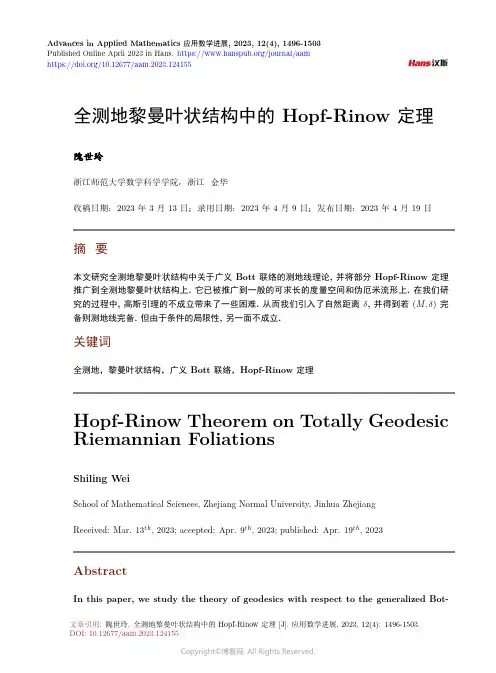
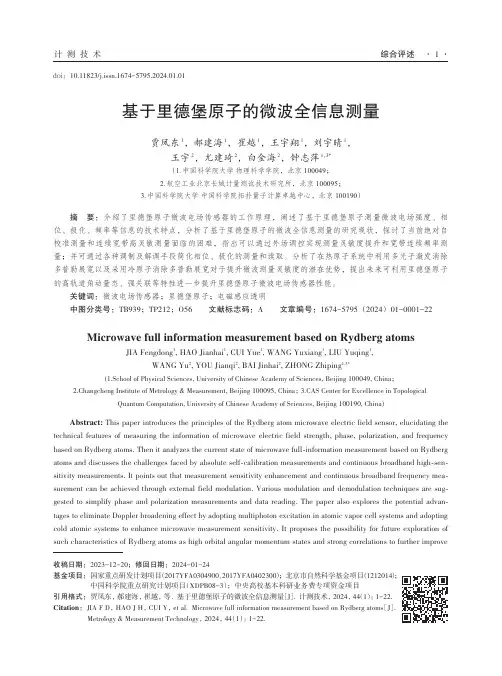
基于里德堡原子的微波全信息测量贾凤东1,郝建海1,崔越1,王宇翔1,刘宇晴1,王宇2,尤建琦2,白金海2,钟志萍1,3*(1.中国科学院大学 物理科学学院,北京 100049;2.航空工业北京长城计量测试技术研究所,北京 100095;3.中国科学院大学 中国科学院拓扑量子计算卓越中心,北京 100190)摘 要:介绍了里德堡原子微波电场传感器的工作原理,阐述了基于里德堡原子测量微波电场强度、相位、极化、频率等信息的技术特点,分析了基于里德堡原子的微波全信息测量的研究现状,探讨了当前绝对自校准测量和连续宽带高灵敏测量面临的困难,指出可以通过外场调控实现测量灵敏度提升和宽带连续频率测量;并可通过各种调制及解调手段简化相位、极化的测量和读取。
分析了在热原子系统中利用多光子激发消除多普勒展宽以及采用冷原子消除多普勒展宽对于提升微波测量灵敏度的潜在优势,提出未来可利用里德堡原子的高轨道角动量态、强关联等特性进一步提升里德堡原子微波电场传感器性能。
关键词:微波电场传感器;里德堡原子;电磁感应透明中图分类号:TB939;TP212;O56 文献标志码:A 文章编号:1674-5795(2024)01-0001-22Microwave full information measurement based on Rydberg atomsJIA Fengdong 1, HAO Jianhai 1, CUI Yue 1, WANG Yuxiang 1, LIU Yuqing 1,WANG Yu 2, YOU Jianqi 2, BAI Jinhai 2, ZHONG Zhiping 1,3*(1.School of Physical Sciences, University of Chinese Academy of Sciences, Beijing 100049, China ;2.Changcheng Institute of Metrology & Measurement, Beijing 100095, China ;3.CAS Center for Excellence in TopologicalQuantum Computation, University of Chinese Academy of Sciences, Beijing 100190, China)Abstract: This paper introduces the principles of the Rydberg atom microwave electric field sensor, elucidating the technical features of measuring the information of microwave electric field strength, phase, polarization, and frequency based on Rydberg atoms. Then it analyzes the current state of microwave full‐information measurement based on Rydberg atoms and discusses the challenges faced by absolute self‐calibration measurements and continuous broadband high‐sen‐sitivity measurements. It points out that measurement sensitivity enhancement and continuous broadband frequency mea‐surement can be achieved through external field modulation. Various modulation and demodulation techniques are sug‐gested to simplify phase and polarization measurements and data reading. The paper also explores the potential advan‐tages to eliminate Doppler broadening effect by adopting multiphoton excitation in atomic vapor cell systems and adoptingcold atomic systems to enhance microwave measurement sensitivity. It proposes the possibility for future exploration of such characteristics of Rydberg atoms as high orbital angular momentum states and strong correlations to further improvedoi :10.11823/j.issn.1674-5795.2024.01.01收稿日期:2023-12-20;修回日期:2024-01-24基金项目:国家重点研发计划项目(2017YFA0304900、2017YFA0402300);北京市自然科学基金项目(1212014);中国科学院重点研究计划项目(XDPB08-3);中央高校基本科研业务费专项资金项目引用格式:贾凤东, 郝建海, 崔越, 等. 基于里德堡原子的微波全信息测量[J ]. 计测技术, 2024, 44(1): 1-22.Citation :JIA F D , HAO J H , CUI Y , et al. Microwave full information measurement based on Rydberg atoms [J ].Metrology & Measurement Technology , 2024, 44(1): 1-22.the performance of Rydberg atom microwave electric field sensors.Key words: microwave electric field sensor; Rydberg atom; electromagnetic induction transparency0 引言对量子状态的主动调控和操纵引发了第二次量子革命,发展出量子通信、量子计算和量子精密测量等前沿领域。
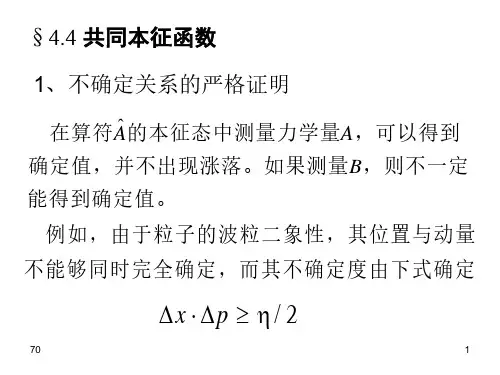
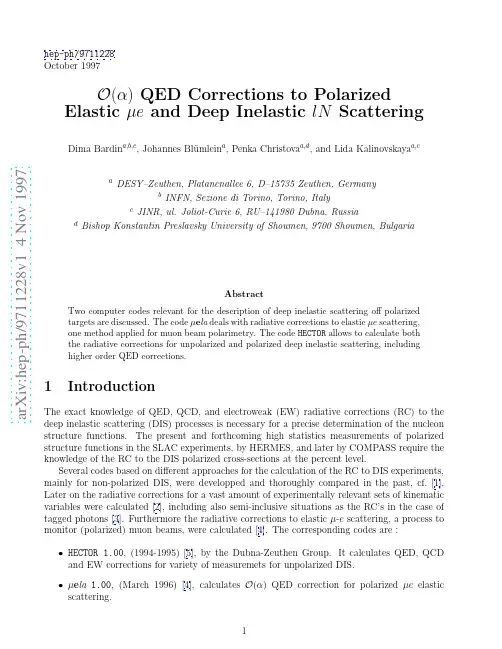
a r X i v :h e p -p h /9711228v 1 4 N o v 1997hep-ph/9711228October 1997O (α)QED Corrections to Polarized Elastic µe and Deep Inelastic lN ScatteringDima Bardin a,b,c ,Johannes Bl¨u mlein a ,Penka Christova a,d ,and Lida Kalinovskaya a,caDESY–Zeuthen,Platanenallee 6,D–15735Zeuthen,GermanybINFN,Sezione di Torino,Torino,ItalycJINR,ul.Joliot-Curie 6,RU–141980Dubna,RussiadBishop Konstantin Preslavsky University of Shoumen,9700Shoumen,BulgariaAbstractTwo computer codes relevant for the description of deep inelastic scattering offpolarized targets are discussed.The code µe la deals with radiative corrections to elastic µe scattering,one method applied for muon beam polarimetry.The code HECTOR allows to calculate both the radiative corrections for unpolarized and polarized deep inelastic scattering,including higher order QED corrections.1IntroductionThe exact knowledge of QED,QCD,and electroweak (EW)radiative corrections (RC)to the deep inelastic scattering (DIS)processes is necessary for a precise determination of the nucleon structure functions.The present and forthcoming high statistics measurements of polarized structure functions in the SLAC experiments,by HERMES,and later by COMPASS require the knowledge of the RC to the DIS polarized cross-sections at the percent level.Several codes based on different approaches for the calculation of the RC to DIS experiments,mainly for non-polarized DIS,were developped and thoroughly compared in the past,cf.[1].Later on the radiative corrections for a vast amount of experimentally relevant sets of kinematic variables were calculated [2],including also semi-inclusive situations as the RC’s in the case of tagged photons [3].Furthermore the radiative corrections to elastic µ-e scattering,a process to monitor (polarized)muon beams,were calculated [4].The corresponding codes are :•HECTOR 1.00,(1994-1995)[5],by the Dubna-Zeuthen Group.It calculates QED,QCD and EW corrections for variety of measuremets for unpolarized DIS.•µe la 1.00,(March 1996)[4],calculates O (α)QED correction for polarized µe elastic scattering.•HECTOR1.11,(1996)extends HECTOR1.00including the radiative corrections for polarized DIS[6],and for DIS with tagged photons[3].The beta-version of the code is available from http://www.ifh.de/.2The Programµe laMuon beams may be monitored using the processes ofµdecay andµe scattering in case of atomic targets.Both processes were used by the SMC experiment.Similar techniques will be used by the COMPASS experiment.For the cross section measurement the radiative corrections to these processes have to be known at high precision.For this purpose a renewed calculation of the radiative corrections toσ(µe→µe)was performed[4].The differential cross-section of polarized elasticµe scattering in the Born approximation reads,cf.[7],dσBORNm e Eµ (Y−y)2(1−P e Pµ) ,(1)where y=yµ=1−E′µ/Eµ=E′e/Eµ=y e,Y=(1+mµ/2/Eµ)−1=y max,mµ,m e–muon and electron masses,Eµ,E′µ,E′e the energies of the incoming and outgoing muon,and outgoing electron respectively,in the laboratory frame.Pµand P e denote the longitudinal polarizations of muon beam and electron target.At Born level yµand y e agree.However,both quantities are different under inclusion of radiative corrections due to bremsstrahlung.The correction factors may be rather different depending on which variables(yµor y e)are used.In the SMC analysis the yµ-distribution was used to measure the electron spin-flip asymmetry A expµe.Since previous calculations,[8,9],referred to y e,and only ref.[9]took polarizations into account,a new calculation was performed,including the complete O(α)QED correction for the yµ-distribution,longitudinal polarizations for both leptons,theµ-mass effects,and neglecting m e wherever possible.Furthermore the present calculation allows for cuts on the electron re-coil energy(35GeV),the energy balance(40GeV),and angular cuts for both outgoing leptons (1mrad).The default values are given in parentheses.Up to order O(α3),14Feynman graphs contribute to the cross-section forµ-e scattering, which may be subdivided into12=2×6pieces,which are separately gauge invariantdσQEDdyµ.(2) One may express(2)also asdσQEDdyµ+P e Pµdσpol kk=1−Born cross-section,k=b;2−RC for the muonic current:vertex+bremsstrahlung,k=µµ;3−amm contribution from muonic current,k=amm;4−RC for the electronic current:vertex+bremsstrahlung,k=ee;5−µe interference:two-photon exchange+muon-electron bremsstrahlung interference,k=µe;6−vacuum polarization correction,runningα,k=vp.The FORTRAN code for the scattering cross section(2)µe la was used in a recent analysis of the SMC collaboration.The RC,δA yµ,to the asymmetry A QEDµeshown infigures1and2is defined asδA yµ=A QEDµedσunpol.(4)The results may be summarized as follows.The O(α)QED RC to polarized elasticµe scattering were calculated for thefirst time using the variable yµ.A rather general FORTRAN codeµe la for this process was created allowing for the inclusion of kinematic cuts.Since under the conditions of the SMC experiment the corrections turn out to be small our calculation justifies their neglection. 3Program HECTOR3.1Different approaches to RC for DISThe radiative corrections to deep inelastic scattering are treated using two basic approaches. One possibility consists in generating events on the basis of matrix elements including the RC’s. This approach is suited for detector simulations,but requests a very hughe number of events to obtain the corrections at a high precision.Alternatively,semi-analytic codes allow a fast and very precise evaluation,even including a series of basic cuts andflexible adjustment to specific phase space requirements,which may be caused by the way kinematic variables are experimentally measured,cf.[2,5].Recently,a third approach,the so-called deterministic approach,was followed,cf.[10].It treats the RC’s completely exclusively combining features of fast computing with the possibility to apply any cuts.Some elements of this approach were used inµe la and in the branch of HECTOR1.11,in which DIS with tagged photons is calculated.Concerning the theoretical treatment three approaches are in use to calculate the radiative corrections:1)the model-independent approach(MI);2)the leading-log approximation(LLA); and3)an approach based on the quark-parton model(QPM)in evaluating the radiative correc-tions to the scattering cross-section.In the model-independent approach the QED corrections are only evaluated for the leptonic tensor.Strictly it applies only for neutral current processes.The hadronic tensor can be dealt with in its most general form on the Lorentz-level.Both lepton-hadron corrections as well as pure hadronic corrections are neglected.This is justified in a series of cases in which these corrections turn out to be very small.The leading logarithmic approximation is one of the semi-analytic treatments in which the different collinear singularities of O((αln(Q2/m2l))n)are evaluated and other corrections are neglected.The QPM-approach deals with the full set of diagrams on the quark level.Within this method,any corrections(lepton-hadron interference, EW)can be included.However,it has limited precision too,now due to use of QPM-model itself. Details on the realization of these approaches within the code HECTOR are given in ref.[5,11].3.2O (α)QED Corrections for Polarized Deep Inelastic ScatteringTo introduce basic notation,we show the Born diagramr rr r j r r r r l ∓( k 1,m )l ∓( k 2,m )X ( p ′,M h )p ( p ,M )γ,Z ¨¨¨¨B ¨¨¨¨£¢ ¡£¢ ¡£¢ ¡£¢ ¡£¢ ¡£¢ ¡£¢ ¡£¢ ¡£¢ ¡£¢ ¡z r r r r r r r r r r r r r rr ¨¨¨¨B ¨¨¨¨r r r r j r r r r and the Born cross-section,which is presented as the product of the leptonic and hadronic tensordσBorn =2πα2p.k 1,x =Q 2q 2F 1(x,Q 2)+p µ p ν2p.qF 3(x,Q 2)+ie µνλσq λs σ(p.q )2G 2(x,Q 2)+p µ s ν+ s µ p νp.q1(p.q )2G 4(x,Q 2)+−g µν+q µq νp.qG 5(x,Q 2),(8)wherep µ=p µ−p.qq 2q µ,and s is the four vector of nucleon polarization,which is given by s =λp M (0, n )in the nucleonrest frame.The combined structure functions in eq.(8)F1,2(x,Q2)=Q2e Fγγ1,2(x,Q2)+2|Q e|(v l−p eλl a l)χ(Q2)FγZ1,2(x,Q2)+ v2l+a2l−2p eλl v l a l χ2(Q2)F ZZ1,2(x,Q2),F3(x,Q2)=2|Q e|(p e a l−λl v l)χ(Q2)FγZ3(x,Q2),+ 2p e v l a l−λl v2l+a2l χ2(Q2)F ZZ3(x,Q2),G1,2(x,Q2)=−Q2eλl gγγ1,2(x,Q2)+2|Q e|(p e a l−λl v l)χ(Q2)gγZ1,2(x,Q2),+ 2p e v l a l−λl v2l+a2l χ2(Q2)g ZZ1,2(x,Q2),G3,4,5(x,Q2)=2|Q e|(v l−p eλl a l)χ(Q2)gγZ3,4,5(x,Q2),+ v2l+a2l−2p eλl v l a l χ2(Q2)g ZZ3,4,5(x,Q2),(9) are expressed via the hadronic structure functions,the Z-boson-lepton couplings v l,a l,and the ratio of the propagators for the photon and Z-bosonχ(Q2)=Gµ2M2ZQ2+M2Z.(10)Furthermore we use the parameter p e for which p e=1for a scattered lepton and p e=−1for a scattered antilepton.The hadronic structure functions can be expressed in terms of parton densities accounting for the twist-2contributions only,see[12].Here,a series of relations between the different structure functions are used in leading order QCD.The DIS cross-section on the Born-leveld2σBorndxdy +d2σpol Borndxdy =2πα2S ,S U3(y,Q2)=x 1−(1−y)2 ,(13) and the polarized partdσpol BornQ4λp N f p S5i=1S p gi(x,y)G i(x,Q2).(14)Here,S p gi(x,y)are functions,similar to(13),and may be found in[6].Furthermore we used the abbrevationsf L=1, n L=λp N k 12πSy 1−y−M2xy2π1−yThe O(α)DIS cross-section readsd2σQED,1πδVRd2σBorndx l dy l=d2σunpolQED,1dx l dy l.(16)All partial cross-sections have a form similar to the Born cross-section and are expressed in terms of kinematic functions and combinations of structure functions.In the O(α)approximation the measured cross-section,σrad,is define asd2σraddx l dy l +d2σQED,1dx l dy l+d2σpol radd2σBorn−1.(18)The radiative corrections calculated for leptonic variables grow towards high y and smaller values of x.Thefigures compare the results obtained in LLA,accounting for initial(i)andfinal state (f)radiation,as well as the Compton contribution(c2)with the result of the complete calculation of the leptonic corrections.In most of the phase space the LLA correction provides an excellent description,except of extreme kinematic ranges.A comparison of the radiative corrections for polarized deep inelastic scattering between the codes HECTOR and POLRAD[17]was carried out.It had to be performed under simplified conditions due to the restrictions of POLRAD.Corresponding results may be found in[11,13,14].3.3ConclusionsFor the evaluation of the QED radiative corrections to deep inelastic scattering of polarized targets two codes HECTOR and POLRAD exist.The code HECTOR allows a completely general study of the radiative corrections in the model independent approach in O(α)for neutral current reac-tions including Z-boson exchange.Furthermore,the LLA corrections are available in1st and2nd order,including soft-photon resummation and for charged current reactions.POLRAD contains a branch which may be used for some semi-inclusive DIS processes.The initial state radia-tive corrections(to2nd order in LLA+soft photon exponentiation)to these(and many more processes)can be calculated in detail with the code HECTOR,if the corresponding user-supplied routine USRBRN is used together with this package.This applies both for neutral and charged current processes as well as a large variety of different measurements of kinematic variables. Aside the leptonic corrections,which were studied in detail already,further investigations may concern QED corrections to the hadronic tensor as well as the interference terms. References[1]Proceedings of the Workshop on Physics at HERA,1991Hamburg(DESY,Hamburg,1992),W.Buchm¨u ller and G.Ingelman(eds.).[2]J.Bl¨u mlein,Z.Phys.C65(1995)293.[3]D.Bardin,L.Kalinovskaya and T.Riemann,DESY96–213,Z.Phys.C in print.[4]D.Bardin and L.Kalinovskaya,µe la,version1.00,March1996.The source code is availablefrom http://www.ifh.de/~bardin.[5]A.Arbuzov,D.Bardin,J.Bl¨u mlein,L.Kalinovskaya and T.Riemann,Comput.Phys.Commun.94(1996)128,hep-ph/9510410[6]D.Bardin,J.Bl¨u mlein,P.Christova and L.Kalinovskaya,DESY96–189,hep-ph/9612435,Nucl.Phys.B in print.[7]SMC collaboration,D.Adams et al.,Phys.Lett.B396(1997)338;Phys.Rev.D56(1997)5330,and references therein.[8]A.I.Nikischov,Sov.J.Exp.Theor.Phys.Lett.9(1960)757;P.van Nieuwenhuizen,Nucl.Phys.B28(1971)429;D.Bardin and N.Shumeiko,Nucl.Phys.B127(1977)242.[9]T.V.Kukhto,N.M.Shumeiko and S.I.Timoshin,J.Phys.G13(1987)725.[10]G.Passarino,mun.97(1996)261.[11]D.Bardin,J.Bl¨u mlein,P.Christova,L.Kalinovskaya,and T.Riemann,Acta Phys.PolonicaB28(1997)511.[12]J.Bl¨u mlein and N.Kochelev,Phys.Lett.B381(1996)296;Nucl.Phys.B498(1997)285.[13]D.Bardin,J.Bl¨u mlein,P.Christova and L.Kalinovskaya,Preprint DESY96–198,hep-ph/9609399,in:Proceedings of the Workshop‘Future Physics at HERA’,G.Ingelman,A.De Roeck,R.Klanner(eds.),Vol.1,p.13;hep-ph/9609399.[14]D.Bardin,Contribution to the Proceedings of the International Conference on High EnergyPhysics,Warsaw,August1996.[15]M.Gl¨u ck,E.Reya,M.Stratmann and W.Vogelsang,Phys.Rev.D53(1996)4775.[16]S.Wandzura and F.Wilczek,Phys.Lett.B72(1977)195.[17]I.Akushevich,A.Il’ichev,N.Shumeiko,A.Soroko and A.Tolkachev,hep-ph/9706516.-20-18-16-14-12-10-8-6-4-200.10.20.30.40.50.60.70.80.91elaFigure 1:The QED radiative corrections to asymmetry without experimental cuts.-1-0.8-0.6-0.4-0.200.20.40.60.810.10.20.30.40.50.60.70.80.91elaFigure 2:The QED radiative corrections to asymmetry with experimental cuts.-50-40-30-20-100102030405000.10.20.30.40.50.60.70.80.91HectorFigure 3:A comparison of complete and LLA RC’s in the kinematic regime of HERMES for neutral current longitudinally polarized DIS in leptonic variables.The polarized parton densities [15]are used.The structure function g 2is calculated using the Wandzura–Wilczek relation.c 2stands for the Compton contribution,see [6]for details.-20-100102030405000.10.20.30.40.50.60.70.80.91HectorFigure 4:The same as in fig.3,but for energies in the range of the SMC-experiment.-20-10010203040500.10.20.30.40.50.60.70.80.91HectorFigure 5:The same as in fig.4for x =10−3.-200-150-100-5005010015020000.10.20.30.40.50.60.70.80.91HectorFigure 6:A comparison of complete and LLA RC’s at HERA collider kinematic regime for neutral current deep inelastic scattering offa longitudinally polarized target measuring the kinematic variables at the leptonic vertex.。
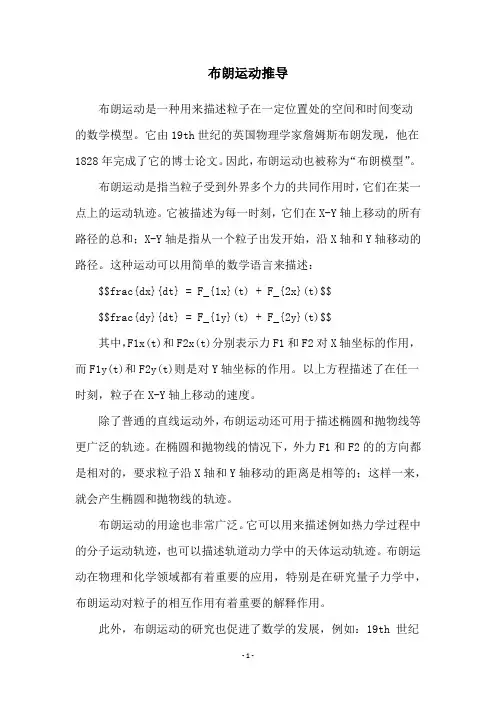
布朗运动推导布朗运动是一种用来描述粒子在一定位置处的空间和时间变动的数学模型。
它由19th世纪的英国物理学家詹姆斯布朗发现,他在1828年完成了它的博士论文。
因此,布朗运动也被称为“布朗模型”。
布朗运动是指当粒子受到外界多个力的共同作用时,它们在某一点上的运动轨迹。
它被描述为每一时刻,它们在X-Y轴上移动的所有路径的总和;X-Y轴是指从一个粒子出发开始,沿X轴和Y轴移动的路径。
这种运动可以用简单的数学语言来描述:$$frac{dx}{dt} = F_{1x}(t) + F_{2x}(t)$$$$frac{dy}{dt} = F_{1y}(t) + F_{2y}(t)$$其中,F1x(t)和F2x(t)分别表示力F1和F2对X轴坐标的作用,而F1y(t)和F2y(t)则是对Y轴坐标的作用。
以上方程描述了在任一时刻,粒子在X-Y轴上移动的速度。
除了普通的直线运动外,布朗运动还可用于描述椭圆和抛物线等更广泛的轨迹。
在椭圆和抛物线的情况下,外力F1和F2的的方向都是相对的,要求粒子沿X轴和Y轴移动的距离是相等的;这样一来,就会产生椭圆和抛物线的轨迹。
布朗运动的用途也非常广泛。
它可以用来描述例如热力学过程中的分子运动轨迹,也可以描述轨道动力学中的天体运动轨迹。
布朗运动在物理和化学领域都有着重要的应用,特别是在研究量子力学中,布朗运动对粒子的相互作用有着重要的解释作用。
此外,布朗运动的研究也促进了数学的发展,例如:19th 世纪的德国数学家高斯用布朗运动来推导出了移动中心定理;贝塞尔在20世纪初就开始使用布朗运动来描述艺术作品中几何图形的变化。
因此,布朗运动一直以来都是物理、数学和艺术众多学科中重要的课题之一,它研究的内容不仅仅是描述粒子在空间及时间上运动的过程,还包括外力如何作用于粒子,以及外力和质量的影响等微观物理现象,也同时涉及到多学科的内容。
总的来说,布朗运动是一种重要的数学模型,用于描述物理过程中粒子在空间及时间上运动的轨迹,这种运动被描述为外力对X-Y轴坐标的作用。
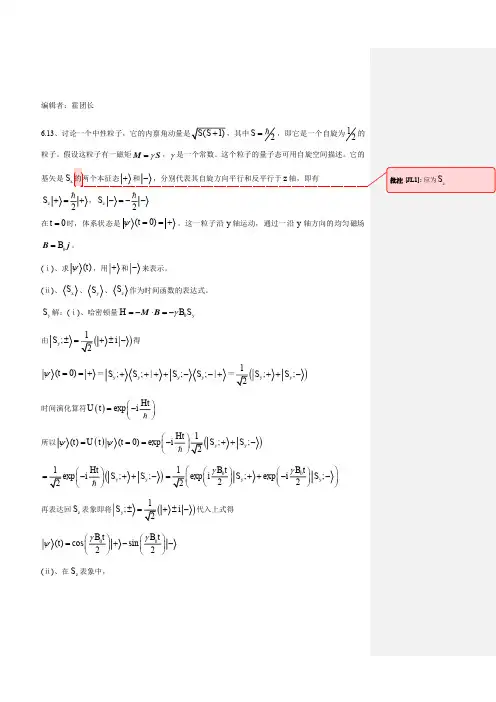

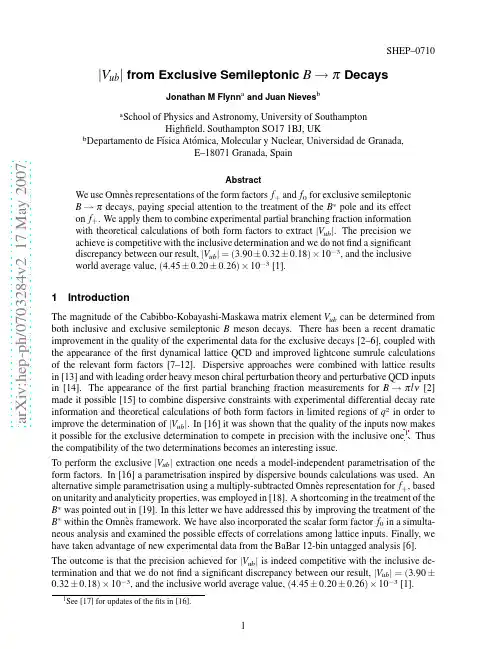
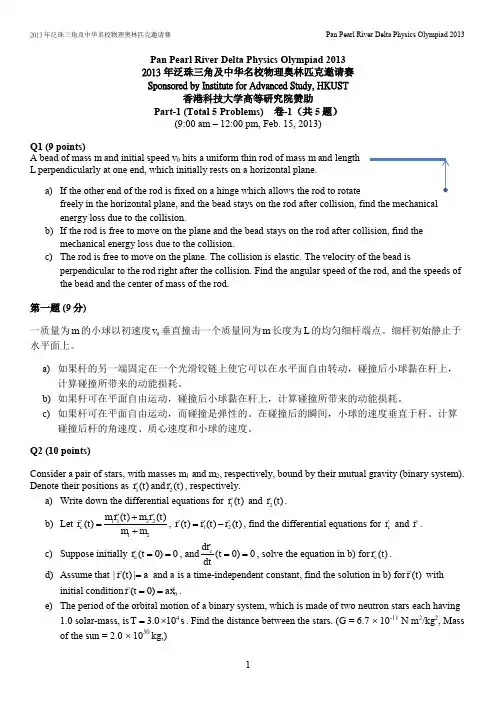
Pan Pearl River Delta Physics Olympiad 20132013年泛珠三角及中华名校物理奥林匹克邀请赛Sponsored by Institute for Advanced Study, HKUST香港科技大学高等研究院赞助Part-1 (Total 5 Problems) 卷-1(共5题)(9:00 am – 12:00 pm, Feb. 15, 2013)Q1 (9 points)A bead of mass m and initial speed v 0 hits a uniform thin rod of mass m and lengthL perpendicularly at one end, which initially rests on a horizontal plane.a) If the other end of the rod is fixed on a hinge which allows the rod to rotatefreely in the horizontal plane, and the bead stays on the rod after collision, find the mechanicalenergy loss due to the collision.b) If the rod is free to move on the plane and the bead stays on the rod after collision, find themechanical energy loss due to the collision.c) The rod is free to move on the plane. The collision is elastic. The velocity of the bead isperpendicular to the rod right after the collision. Find the angular speed of the rod, and the speeds ofthe bead and the center of mass of the rod.第一题 (9分)一质量为m 的小球以初速度0v 垂直撞击一个质量同为m 长度为L 的均匀细杆端点。
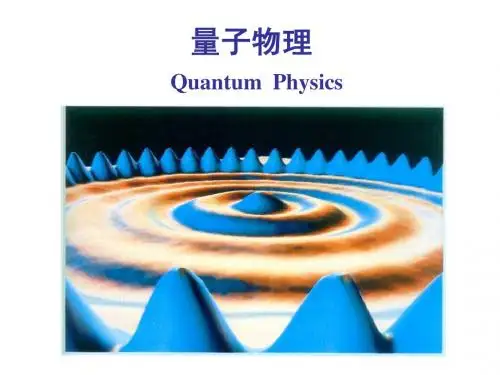
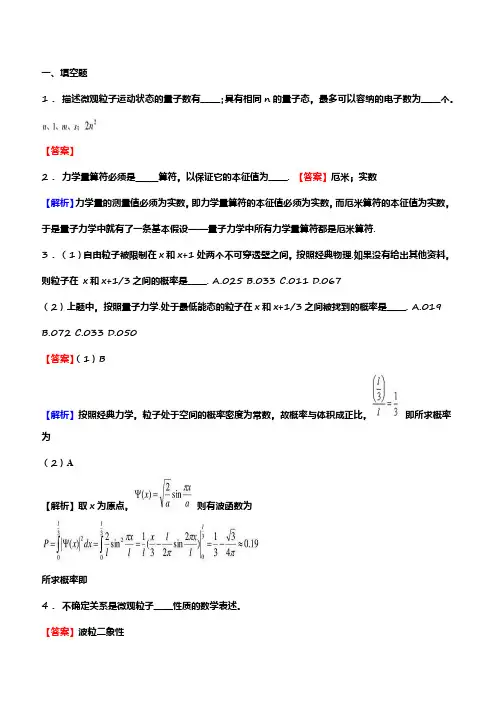
一、填空题1.描述微观粒子运动状态的量子数有_____;具有相同n的量子态,最多可以容纳的电子数为_____个。
【答案】2.力学量算符必须是_____算符,以保证它的本征值为_____. 【答案】厄米;实数【解析】力学量的测量值必须为实数,即力学量算符的本征值必须为实数,而厄米算符的本征值为实数,于是量子力学中就有了一条基本假设——量子力学中所有力学量算符都是厄米算符.3.(1)自由粒子被限制在x和x+1处两个不可穿透壁之间,按照经典物理.如果没有给出其他资料,则粒子在 x和x+1/3之间的概率是_____. A.025 B.033 C.011 D.067(2)上题中,按照量子力学.处于最低能态的粒子在x和x+1/3之间被找到的概率是_____. A.019 B.072 C.033 D.050【答案】(1)B【解析】按照经典力学,粒子处于空间的概率密度为常数,故概率与体积成正比,即所求概率为(2)A【解析】取x为原点,则有波函数为所求概率即4.不确定关系是微观粒子_____性质的数学表述。
【答案】波粒二象性5.一维谐振子升、降算符、a的对易关系式为_____;粒子数算符N与、a的关系是;哈密顿量H 用N或、a表示的式子是_____;N(亦即H)的归一化本征态为_____。
【答案】6.—粒子的波函数为写出粒子位于间的几率的表达式_____。
【答案】二、选择题7.__________。
【答案】8.设粒子处于态为归一化波函数为归一化的球谐函数,则系数的取值为_____的可能值为_____的平均值为_____。
【答案】9.(1)_____;(2)_____。
【答案】10.下面关于厄米算符的定义式中.正确的为().【答案】A【解析】量子力学中力学量对应的算符必须为厄米算符,这是因为力学量算符的本征值必须为实数.厄米算符定义式为11.量子谐振子的能量是().【答案】A【解析】由于谐振子的哈密顿算符为而本征值为n,于是谐振子能量为第 4 页,共 47 页12.设粒子处于态为归一化的球谐函数,则的平均值为()。
1下列人物中最早使用“物理学”这个词的是谁?(D)A、牛顿B、伽利略C、爱因斯坦D、亚里斯多德2相对论是关于(A)的基本理论,分为狭义相对论和广义相对论。
A、时空和引力B、时空和重力C、时间和空间D、引力和重力3“格物穷理”是由谁提出来的?(B)A、张载B、朱熹C、陆九渊D、王阳明4欧洲奴隶社会比中国时间长,中国封建社会比西方时间长。
(√)5西方在中世纪有很多创造。
(×)1惯性定律认为物体在不受任何外力的作用下,会保持下列哪种运动状态?(C)A、匀速曲线B、加速直线C、匀速直线D、加速曲线2以下不属于伽利略的成就的是(B )A、重述惯性定律B、发现万有引力C、阐述相对性原理D、自由落体定律3《关于托勒密和哥白尼两大世界体系的对话》与《天体运行论》都是伽利略的著作(×) 4伽利略是奥地利物理学家,近代实验科学的先驱者。
(×)5伽利略认为斜面上的运动是冲淡了的自由落体运动。
(√)1 “热力学第三定律”的发现者是谁?(B)A、克劳修斯B、能斯特C、开尔文D、焦耳2以下哪一项属于经典物理的范畴(A)A、万有引力定律B、热质学说C、量子论D、狭义相对性原理我的答案:A 得分:20.0分3下面哪项不属于电磁学定律?(C)A、库仑定律B、安培定律C、能斯特定理D、电磁感应定律4牛顿的认同伽利略的相对性原理,没有绝对时空观。
(×)5光学上的“波动说”是由牛顿提出来的。
(×)1紫外灾难是指(C)A、维恩线在短波波段与实验值的巨大差异B、维恩线在长波波段与实验值的巨大差异C、瑞利-金斯线在短波波段与实验值的巨大差异D、瑞利-金斯线在长波波段与实验值的巨大差异2最早提出量子假说的是(B)A、爱因斯坦B、普朗克C、能斯特D、汤姆逊3哪条线与平衡热辐射实验值在长波和短波波段都吻合(C)A、维恩线B、瑞丽-金斯线C、普朗克线D、爱因斯坦线4爱因斯坦提出光量子说之后,普朗克立即表示赞同。
a rXiv:h ep-ph/94827v415J un1995Phys.Rev.Lett.74,4400(1995)A new cross term in the two-particle Hanbury-Brown-Twiss correlation function Scott Chapman,Pierre Scotto and Ulrich Heinz Institut f¨u r Theoretische Physik,Universit¨a t Regensburg,D-93040Regensburg,Germany Abstract Using two specific models and a model-independent formalism,we show that in addition to the usual quadratic “side”,“out”and “longitudinal”terms,a previously neglected “out-longitudinal”cross term arises naturally in the exponent of the two-particle correlator.Since its effects can be easily observed,such a term should be included in any experimental fits to correlation data.We also suggest a method of organizing correlation data using rapidity rather than longitudinal momentum differences since in the former every relevant quantity is longitudinally boost invariant.25.70.PqTypeset using REVT E XThe experimentally measured Hanbury-Brown Twiss(HBT)correlation between two identical particles emitted in a high energy collision defines a six dimensional function of the momenta p1and p2[1].A popular way of presenting these is in terms“size parameters”derived from a gaussianfit to the data of the form[2–5]C(q,K)=1±λexp −q2s R2s(K)−q2o R2o(K)−q2l R2l(K) (1) where q=p1−p2,K=1| d4x S(x,K)|2(3) where q0=E1−E2,K0=E K=q·x≃(βo q o+βl q l)t−q o x−q s y−q l z,(4)whereβi=K i/E K.As a simple example,we consider the following cylindrically symmetric gaussian emission functionS(x,K)=f(K)exp −x2+y22L2−(t−t0)21−β2l,t′z′terms arise in the transformed emission function S′.These in turn lead to a nonvanishing cross term of the formR′2ol=βoβlγ2l (δt)2+L2 ,(8) whereβl andγl are evaluated in the CM frame.We can see that the cross term cannot in general be removed simply by transforming to another coordinate system or reference frame,and therefore it is certainly not just a trivial kinematic effect.In fact,R2ol contains physical information about the emitting source which is just as important as that found from evaluating the difference R2o−R2s.In order to get a broader feeling for what the cross term measures,we now introduce a general formalism valid for any cylindrically symmetric emission function which can be expressed in a roughly gaussian ing(4),we expand exp(iq·x)in(3)for q·x≪1to find(see[11])C(q,K)=1± 1−q2s y2 − [q o(βo t−x)+q l(βl t−z)]2+ q o(βo t−x)+q l(βl t−z) 2+O (q·x)4 ,(9) where the q s q o and q s q l terms vanish due to cylindrical symmetry[8]and we have introduced the notationξ ≡ ξ (K)= d4xξS(x,K)For a static source,these homogeneity lengths are equal to its geometric size in the various directions which can then be directly extracted from the HBT correlator.For expanding sources the interpretation of the HBT size parameters is more involved[7–10,12,13],and the HBT parameters are usually smaller than the geometric extensions of the source.The cross term is seen to measure the temporal extent of the source as well as the x z,x t,and z t correlations of the emission function.Note that the LCMS radii can be found from(11) by settingβl=0and using S(x′,K′)(see Eq.(7)).The cross term vanishes in this frame if and only if the source S(x′,K′)is reflection symmetric under z′→−z′(which is not the case for our source(5)).One might argue that the model independent expressions of Eq.(11)should not be compared to experimental correlation radii since the former measure second derivatives of the correlation function around q=0(because we used q·x≪1to derive them),while the latter are parameters of a gaussianfit to the whole correlation function[2–5].On the other hand,for any source which has a roughly gaussian profile in some complete set of spatial coordinates,the two different methods of measuring radii will give roughly the same results.For these types of models,the simple expressions generated by Eq.(11)provide valuable insights as to how various parameters of the source distribution qualitatively affect measurable features of the correlation function.We already discussed one gaussian model in Eq.(5),but here we would like to discuss another,possibly more realistic model which is similar to the ones presented in[13].In the center of mass frame of an expandingfireball,we define the following emission functionS(x,K)=τ0m t ch(η−Y)2π(δτ)2exp −K·u(x)2R2G−η22(δτ)2 ,(12)where T is a constant freeze-out temperature,ρ=√t2−z2,η=1m2+K2⊥,and Y is the rapidity of a particle with momentum K.Note that in the limitδτ→0,(12)becomes the Boltzmann approximation for a hydrodynamic system with localflow velocity u(x)which freezes out on a3-dimensional hypersurface of constant longitudinal proper timeτ0and temperature T[14,8].We willconsider aflow which is non-relativistic transversally but which exhibits Bjorken expansion longitudinallyu(x)≃ 1+12(vρ/R G)2 shη ,(13) where v≪1is the transverseflow velocity of thefluid atρ=R G.In[8]we show that when the emission function(12)is integrated over spacetime,it produces a very reasonable one-particle distribution.To facilitate calculating the correlation function,we can make the physically reasonable assumption thatδτ/τ0<∼1(δη)2∗=1T.(14)Note that for pairs in which m t/T≫1/(δη)2as were studied in[15],(δη)2∗becomes simply T/m t.Using the expressions(11)and keeping a few subleading corrections which are important when considering pions[8],wefindR2s=R2∗;R2o=R2∗+K2⊥m2tβ2lτ20(δη)2∗+K2⊥(δη)2 (δτ)2(δη)2∗+K2⊥(δη)2+1E2K τ20(δη)2∗+m2tE2Kντ20(δη)4∗;R2ol=−βoβlτ20(δη)2∗−βo βl−Y(δη)2 (δη)4∗.(15) where1R2G 1+m tandν=1+(R∗/R G)2−1cannot be completely boost invariant,so it will in general feature a nonvanishing cross term in the LCMS,since the LCMS does not coincide with the local rest frame[18].We would now like to suggest a better way of organizing correlation data from sources undergoing boost-invariant longitudinal expansion[19].Returning to(3),let us make an alternative on-shell definition of the4-vector K:K=(m t ch Y,K t,m t sh Y)(17)where K t=12(y1+y2),and y i is the rapidity of the i th particle.The resulting approximation is at least as good as the approximation we have been using up to now[8].This definition suggests that we express the correlation function in terms of q s,q o and the rapidity difference y=y1−y2:C(y,q s,q o,Y,K⊥)≃1±λexp[−q2s R2s−q2o R2o−y2α2−2q o y R o y].(18) The reader should take care not to confuse the rapidity difference y with the cartesian coordinate y.The model independent expressions corresponding to(11)are now given by:R2s= y2R2o= [x−(K⊥/m t)τch(η−Y)]2 − x−(K⊥/m t)τch(η−Y) 2α2= [m tτsh(η−Y)]2 − m tτsh(η−Y) 2R o y= [m t x−K⊥τch(η−Y)]τsh(η−Y) − m t x−K⊥τch(η−Y) τsh(η−Y) .(19) For the model(12),the radii take the much simpler form:R2s=R2∗R2o=R2∗+K2⊥2(δη)4∗τ20α2=m2t(δη)2∗ τ20 1+ν(δη)2∗ +(δτ)2 R o y=K⊥YThe astute reader will note that the above“side”and“out”radii are identical to the LCMS versions of(15),and that aside from a slight difference in the definition of Y,R l(LCMS)=α/m t and R2ol(LCMS)=R o y/m t.In fact,for systems undergoing Bjorken longitudinal expansion,LCMS correlation functions are nothing more than approximations tofixed frame correlation functions in rapidity coordinates[8].Using the same source parameters as in Fig.1,the effect of the cross term can be seen in Fig.2where we plot the correlator as a function of y for q o=30MeV.The accuracy of the analytic approximation(dashed)is seen by comparing it with the exact numerical result (solid).We have shown that an“out-longitudinal”(or“out-rapidity”)cross term arises naturally both in a general gaussian derivation of the correlation function and in two specific gaussian models.Although transformed,in general the cross term persists when one switches from calculating momentum differences in afixed frame to calculating them in the LCMS.Con-sequently,there is no reason why such a term should be excluded a priori from gaussianfits to experimental correlation data.Not only will the new parameter reveal more information about the source,its inclusion will undoubtedly increase the accuracy of the otherfitted radii.ACKNOWLEDGMENTSWe would like to thank U.Mayer,T.Cs¨o rg¨o,M.Gyulassy and Yu.Sinyukov for en-lightening discussions.Financially,this work was supported by BMBF and DFG.REFERENCES[1]D.Boal,C.K.Gelbke,and B.Jennings,Rev.Mod.Phys.62(1990)553.[2]NA35Coll.,T.Alber et al.,Phys.Rev.Lett.74,1303(1995).[3]NA35Coll.,G.Roland et al.,Nucl.Phys.A566,527c(1994);NA35Coll.,D.Ferencet al.,Frankfurt preprint IKF-HENPG/2-94(1994);NA44Coll.,M.Sarabura et al., Nucl.Phys.A544,125c(1992);E802Coll.,T.Abbott et al.,Phys.Rev.Lett.69,1030 (1992).[4]NA35Coll.,P.Seyboth et al.,Nucl.Phys.A544,293c(1992);NA35Coll.,D.Ferencet al.,Nucl.Phys.A544,531c(1992).[5]NA44Coll.,H.Beker et al.,CERN-PPE/94-119,submitted to Phys.Rev.Lett.[6]G.Bertsch,M.Gong,and M.Tohyama,Phys.Rev.C37,1896(1988).[7]S.Pratt,T.Cs¨o rg¨o and J.Zimanyi,Phys.Rev.C42,2646(1990).[8]S.Chapman,P.Scotto and U.Heinz,hep-ph/9409349,Heavy Ion Physics1,1(1995).[9]S.Pratt et al.,Nucl.Phys.A566(1994)103c;M.Lisa et al.,Phys.Rev.Lett.71,2863(1993).[10]T.Cs¨o rg¨o and S.Pratt,in:Proc.of the Workshop on Relativistic Heavy Ion Physics,Budapest,KFKI-1991-28/A,p.75.[11]G.Bertsch,P.Danielewicz,and M.Herrmann,Phys.Rev.C49,442(1994).[12]Yu.Sinyukov,in Hot Hadronic Matter:Theory and Experiment,edited by J.Letessieret al.(Plenum,New York,1995),in press.[13]T.Cs¨o rg¨o,Lund U.preprint LUNFD6(NFFL-7081)(1994),Phys.Lett.B,in press;T.Cs¨o rg¨o and B.Lørstad,Lund U.preprint LUNFD6(NFFL-7082)(1994).[14]B.R.Schlei et.al.,Phys.Lett.B293,275(1992);J.Bolz et.al.,Phys.Lett.B300,404(1993).[15]A.Makhlin and Yu.Sinyukov,Z.Phys.C39,69(1988).[16]This effect arises at a higher order in(δη)∗than was studied in[13].[17]NA35Coll.,T.Alber et al.,talk given at Quark Matter’95,Monterey,Jan.6-13,1995.[18]S.Chapman,J.R.Nix and U.Heinz,in preparation.[19]V.Averchenkov et al.,Sov.J.Nucl.Phys.46,905(1987).11120600-60-12002004000.51C - 1q q L out (MeV).2.4.6.81-.4-.20.2.4C- 1y = y - y 12(pio n s)。